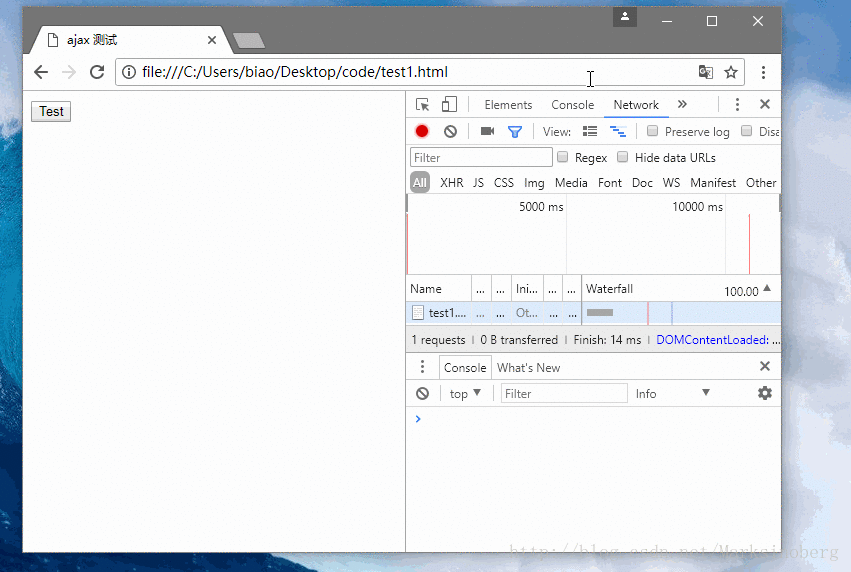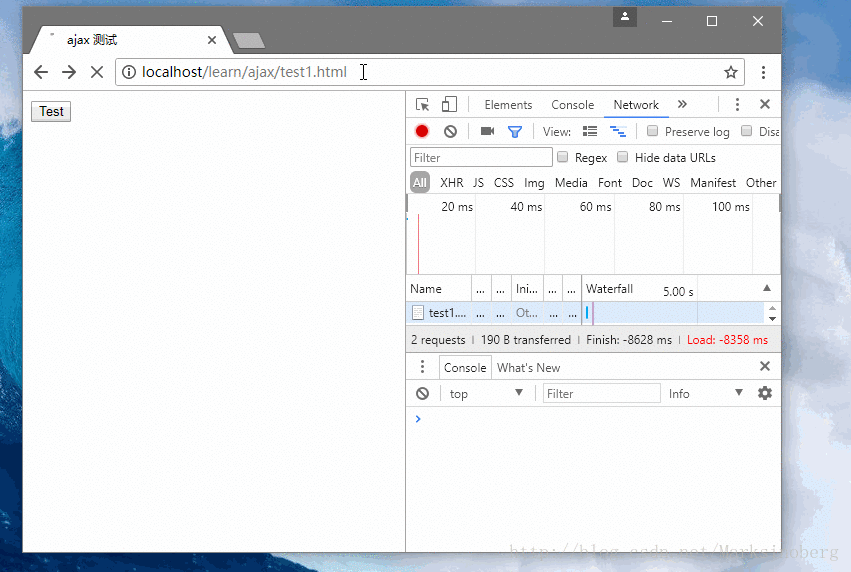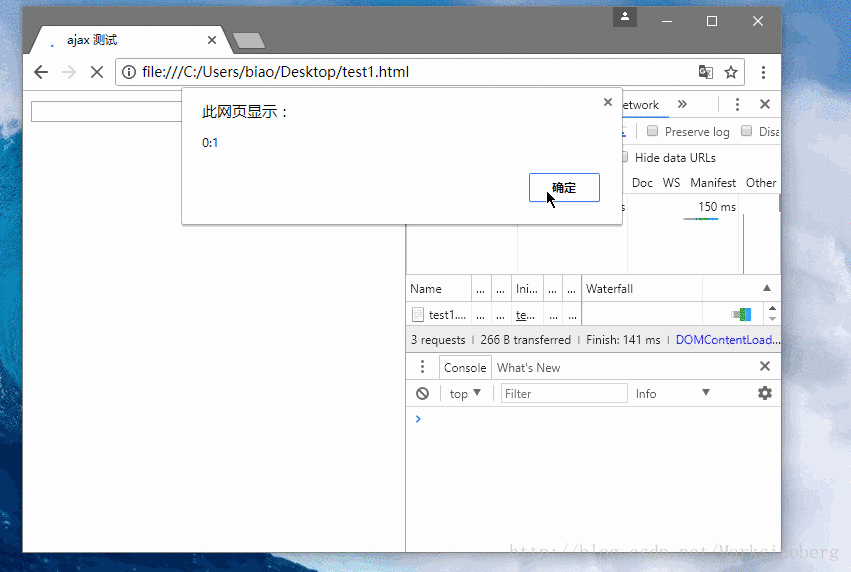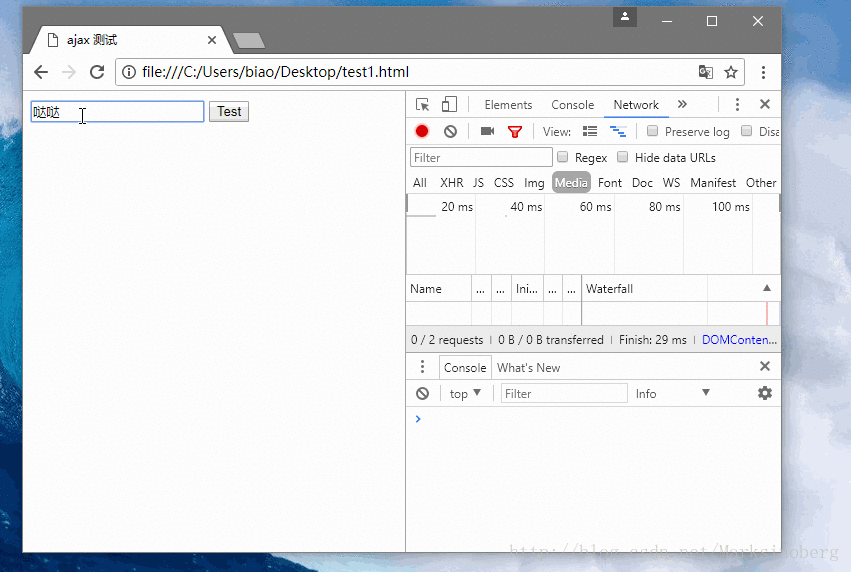
This time I will bring you the perfect solution to the ajax cross-domain problem. What are the precautions for solving the ajax cross-domain problem? The following is a practical case, let’s take a look.
Today I will record some issues about ajax cross-domain. in case for need.Cross-domain
Same-origin policy restrictions
The same-origin policy prevents scripts loaded from one domain from obtaining or operating Document properties on another domain. That is, the domain of the requested URL must be the same as the domain of the current web page. This means that the browser isolates content from different sources to prevent operations between them.Solution
Generally speaking, there are two common ways: one is from the server side, and the other is from the client's perspective. Set off. Both have advantages and disadvantages, and which method to use requires specific analysis.Method 1
The Access-Control-Allow-Origin keyword will take effect only if it is set on the server side. In other words, even if you use xmlhttprequest.setHeaderREquest('xx','xx');
Normal ajax request
Let’s simulate the case implementation of ajax non-cross-domain request. test1.htmlnbsp;html>
<meta>
<title>ajax 测试</title>
<input>
<p></p>
<script>
var xhr = new XMLHttpRequest();
var url = 'http://localhost/learn/ajax/test1.php';
function crossDomainRequest() {
document.getElementById('content').innerHTML = "<font color='red'>loading...";
// 延迟执行
setTimeout(function () {
if (xhr) {
xhr.open('GEt', url, true);
xhr.onreadystatechange = handle_response;
xhr.send(null);
} else {
document.getElementById('content').innerText = "不能创建XMLHttpRequest对象";
}
}, 3000);
}
function handle_response() {
var container = document.getElementById('content');
if (xhr.readyState == 4) {
if (xhr.status == 200 || xhr.status == 304) {
container.innerHTML = xhr.responseText;
} else {
container.innerText = '不能跨域请求';
}
}
}
</script>
<?php echo "It Works."; ?>

Cross-domain request
Just now, the HTML file and the PHP file were both under the Apache container, so there was no cross-domain situation. Now put the HTML file on the desktop and request the PHP data again, creating a situation like this A "cross-domain request".Pay attention to the address bar information of the browser
When you visit again, you will find the following error message.
header("Access-Control-Allow-Origin: *");Response.AddHeader("Access-Control-Allow-Origin", "*");
Direct cross-domain request
Just modify the URL just now and let ajax directly request data from other websites.nbsp;html>
<meta>
<title>ajax 测试</title>
<input>
<p></p>
<script>
var xhr = new XMLHttpRequest();
// var url = 'http://localhost/learn/ajax/test1.php';
var url = 'http://api.qingyunke.com/api.php?key=free&appid=0&msg=%E5%93%92%E5%93%92';
function crossDomainRequest() {
document.getElementById('content').innerHTML = "<font color='red'>loading...";
// 延迟执行
setTimeout(function () {
if (xhr) {
xhr.open('GEt', url, true);
xhr.onreadystatechange = handle_response;
xhr.send(null);
} else {
document.getElementById('content').innerText = "不能创建XMLHttpRequest对象";
}
}, 3000);
}
function handle_response() {
var container = document.getElementById('content');
if (xhr.readyState == 4) {
if (xhr.status == 200 || xhr.status == 304) {
container.innerHTML = xhr.responseText;
} else {
container.innerText = '不能跨域请求';
}
}
}
</script>

Enable proxy mode
For the HTML page just now, we still use our own interface:url = 'http://localhost/learn/ajax/test1.php';
具体如下:
nbsp;html>
<meta>
<title>ajax 测试</title>
<input>
<p></p>
<script>
var xhr = new XMLHttpRequest();
var url = 'http://localhost/learn/ajax/test1.php';
// var url = 'http://api.qingyunke.com/api.php?key=free&appid=0&msg=%E5%93%92%E5%93%92';
function crossDomainRequest() {
document.getElementById('content').innerHTML = "<font color='red'>loading...";
// 延迟执行
setTimeout(function () {
if (xhr) {
xhr.open('GEt', url, true);
xhr.onreadystatechange = handle_response;
xhr.send(null);
} else {
document.getElementById('content').innerText = "不能创建XMLHttpRequest对象";
}
}, 3000);
}
function handle_response() {
var container = document.getElementById('content');
if (xhr.readyState == 4) {
if (xhr.status == 200 || xhr.status == 304) {
container.innerHTML = xhr.responseText;
} else {
container.innerText = '不能跨域请求';
}
}
}
</script>
然后对应的test1.php应该帮助我们实现数据请求这个过程,把“小红的联系方式”要到手,并返回给“小明”。
<?php $url = 'http://api.qingyunke.com/api.php?key=free&appid=0&msg=hello%20world.'; $result = file_get_contents($url); echo $result; ?>
下面看下代码执行的结果。

jsonp方式
JSONP(JSON with Padding) 灵感其实源于在HTML页面中script标签内容的加载,对于script的src属性对应的内容,浏览器总是会对其进行加载。于是:
克服该限制更理想方法是在 Web 页面中插入动态脚本元素,该页面源指向其他域中的服务 URL 并且在自身脚本中获取数据。脚本加载时它开始执行。该方法是可行的,因为同源策略不阻止动态脚本插入,并且将脚本看作是从提供 Web 页面的域上加载的。但如果该脚本尝试从另一个域上加载文档,就不会成功。
实现的思路就是:
在服务器端组装出客户端预置好的json数据,通过回调的方式传回给客户端。
原生实现
nbsp;html>
<meta>
<title>ajax 测试</title>
<script></script>
<input>
<input>
<p></p>
<script>
function jsonpcallback(result) {
for(var i in result) {
alert(i+":"+result[i]);
}
}
var JSONP = document.createElement("script");
JSONP.type='text/javascript';
JSONP.src='http://localhost/learn/ajax/test1.php?callback=jsonpcallback';
document.getElementsByTagName('head')[0].appendChild(JSONP);
</script>
服务器端test1.php内容如下:
<?php $arr = [1,2,3,4,5,6];
$result = json_encode($arr);
echo "jsonpcallback(".$result.")";
?>需要注意的是最后组装的返回值内容。
来看下最终的代码执行效果。

JQuery方式实现
采用原生的JavaScript需要处理的事情还是蛮多的,下面为了简化操作,决定采用jQuery来代替一下。
nbsp;html>
<meta>
<title>ajax 测试</title>
<script></script>
<input>
<input>
<p></p>
<script>
function later_action(msg) {
var element = $("<p><font color='green'>"+msg+"<br />");
$("#content").append(element);
}
$("#btn").click(function(){
// alert($("#talk").val());
$.ajax({
url: 'http://localhost/learn/ajax/test1.php',
method: 'post',
dataType: 'jsonp',
data: {"talk": $("#talk").val()},
jsonp: 'callback',
success: function(callback){
console.log(callback.content);
later_action(callback.content);
},
error: function(err){
console.log(JSON.stringify(err));
},
});
});
</script>
相应的,test1.php为了配合客户端聊天的需求,也稍微做了点改变。
<?php $requestparam = isset($_GET['callback'])?$_GET['callback']:'callback';
// 青云志聊天机器人接口: http://api.qingyunke.com/api.php?key=free&appid=0&msg=hello
// 接收来自客户端的请求内容
$talk = $_REQUEST['talk'];
$result = file_get_contents("http://api.qingyunke.com/api.php?key=free&appid=0&msg=$talk");
// 拼接一些字符串
echo $requestparam . "($result)";
?>最后来查看一下跨域的效果吧。

总结
至此,关于简单的ajax跨域问题,就算是解决的差不多了。对我个人而言,对于这三种方式有一点点自己的看法。
服务器设置Access-Control-Allow-Origin的方式适合信用度高的小型应用或者个人应用。
代理模式则比较适合大型应用的处理。但是需要一个统一的规范,这样管理和维护起来都会比较方便。
JSONP方式感觉还是比较鸡肋的(有可能是我经验还不足,没认识到这个方式的优点吧(⊙﹏⊙)b)。自己玩玩知道有这么个东西好了。维护起来实在是优点麻烦。
相信看了本文案例你已经掌握了方法,更多精彩请关注php中文网其它相关文章!
推荐阅读:
The above is the detailed content of The perfect solution to the ajax cross-domain problem. For more information, please follow other related articles on the PHP Chinese website!




